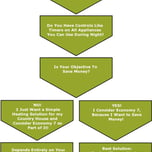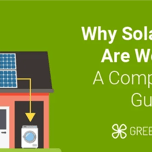Answer these simple questions and we will find you the BEST prices
Which type of solar quotes do you need?
It only takes 30 seconds
100% free with no obligation

Get up to 4 quotes from our selected suppliers by filling in only 1 form

Save money by comparing quotes and choosing the most competitive offer

Our service is 100% free and with no obligation
- GreenMatch
- Blog
- Wireless Power Transfer: The Evolution of Energy
Wireless Power Transfer: The Evolution of Energy
The evolution of wireless energy transfer has been a cornerstone of technological progress, shaping the way we live, work, and interact with our environment. From the discovery of electromagnetic induction by Michael Faraday in 1831 to the development of the Tesla coil by Nikola Tesla in the late 19th and early 20th centuries. However, in the latter half of the 20th century, significant advancements were made, particularly in microwave power transmission for long-distance wireless power transfer.

The quest for efficient and convenient energy transfer has led to exploring wireless power transfer (WPT).
WPT is a game-changing technology that allows the transmission of electrical energy without wires or direct contact. This method offers convenience by eliminating the clutter of cables and enhances safety by reducing the risks associated with electrical connections.
The significance of WPT lies in its potential to revolutionise how we use and manage energy in various applications, from consumer electronics to electric vehicles.
The global market for WPT is experiencing rapid growth, with projections estimating a rise to £37.6 billion by 2030 at a CAGR of 23.3%. This growth is driven by the increasing demand for home entertainment and the rise of consumer electronics as a key application for WPT. Technological advancements, such as the use of Gallium Nitride (GaN) for compact and efficient wireless power transmitters, are facilitating the integration of WPT into everyday life.
With this in mind, wireless energy transfer through microwaves has become viable but needs further technological development to overcome its downsides. This is important as the reliance on solar energy continues to grow on the planet. The possibility of transmitting this energy anywhere on Earth or even more, harnessing energy and transferring it from outer space would have huge benefits, both for the environment and the economy.
The Concept of Wireless Energy Transfer
WPT technologies are becoming increasingly prevalent in consumer electronics, with wireless charging pads for smartphones being just the beginning. The integration of WPT into furniture and vehicles is expected to offer unparalleled convenience, and the development of Internet of Things (IoT) devices and smart homes will likely be significantly influenced by WPT.
Moreover, these technologies can be broadly categorised into near-field (non-radiative) techniques, such as inductive and capacitive coupling, and far-field (radiative) techniques, including microwaves and laser beams.
Near-field techniques are commonly used for charging handheld devices and medical implants, while far-field techniques have potential applications in power satellites and wireless-powered drone aircraft.
Solar Power in Space for Wireless Energy Transfer
Space offers an unobstructed view of the Sun, free from the Earth's atmospheric limitations such as day/night cycles, weather conditions, and seasonal changes. This constant solar exposure means space-based solar power systems can generate up to eight times more energy than terrestrial solar panels.
As of 2012, Japanese scientists were working on the “2012 Solar Power Wireless Transmission Technology Development Project”, which was successful in transmitting solar energy wirelessly. The distance of energy transmission managed by the scientists was just 55 meters. The energy transfer was achieved by using microwaves to deliver through the air 1.8kW of power- enough power to run a small electronic device. However, this experiment was of great importance for the future development of this technology.
Recent advancements have brought this vision closer to reality. Caltech's SSPDin 2023, for instance, successfully transmitted energy wirelessly in space using MAPLE (Microwave Array for Power-transfer Low-orbit Experiment), a system of flexible, lightweight microwave power transmitters. Similarly, the 2024 ESA's SOLARIS initiative aims to explore the necessary technologies to make space-based solar power viable, including wireless power transmission, as demonstrated in Munich, where green energy was wirelessly beamed over 36 meters.
This constant solar exposure means space-based solar power systems can generate up to eight times more energy than terrestrial solar panels.
Environmental Impact
While WPT is a promising technology, it is essential to consider its environmental implications. The efficiency of wireless energy transfer plays a crucial role in its environmental footprint. Higher efficiency means less energy waste and lower carbon emissions. For instance, the production and disposal of components used in WPT systems may introduce hazardous materials into the environment, posing risks to human health and ecosystems.
By replacing batteries, which contribute to landfill toxicity, WPT can help prevent environmental degradation. Moreover, the efficiency of WPT systems can reduce reliance on fossil fuels, making it a potentially eco-friendly technology.
However, the actual impact of WPT on the environment depends on various factors, including the source of the electricity used for power transfer and the materials and processes involved in manufacturing WPT systems.
Efficiency Impact of Wireless Power Transfer
| Technology | Efficiency | Potential Environmental Benefits | Potential Environmental Risks |
| Near-field (Inductive/Capacitive) | High | Reduces need for disposable batteries; Decreases reliance on fossil fuels | Production and disposal of components may introduce hazardous materials |
| Far-field (Microwaves/Laser) | Varies | Enables remote power delivery; Potential for solar power satellites | Energy transmission efficiency; Potential hazards from electromagnetic radiation |
WPT and the Environment
| Factor | Impact on Environment | Notes |
| Efficiency | Lower efficiency can lead to higher energy consumption and emissions | Improvements in WPT technology aim to increase efficiency |
| Energy Source | Use of renewable energy sources can reduce carbon footprint | Integration with solar or wind power is beneficial |
| Manufacturing | Production processes and materials used can affect the environment | Sustainable practices and materials are crucial |
| End-of-Life | Disposal and recycling of WPT systems | Design for recyclability can minimise environmental impact |
Technologies Behind Wireless Power Transfer
By understanding the underlying technologies and their respective advantages, we can better harness this technology for a more convenient and potentially greener future.
This technology's popularity over the past few years has made it more convenient and flexible for various applications.
We will look at the WPT categories divided into two main techniques: near-field (non-radiative) and far-field (radiative).
Near-field (Non-radiative) Techniques
Near-field techniques transfer power over short distances and are primarily used for charging portable devices and electric vehicles.
- Inductive Coupling: This method involves a transmitter coil that generates an electromagnetic field and a receiver coil that captures this field to produce electricity. It's widely used for charging electric toothbrushes, smartphones, and smartwatches.
- Resonant Inductive Coupling: An advancement of inductive coupling, this technique enhances efficiency and allows for a slightly larger distance between the transmitter and receiver coils. It's achieved by tuning both coils to the same frequency, enabling applications like charging electric vehicles more efficiently.
- Capacitive Coupling: Utilises electric fields for power transfer between two metal electrodes, which can benefit applications requiring very thin or flexible transmitters and receivers, such as powering or charging through surfaces.
Far-field (Radiative) Techniques
Far-field techniques, however, are suitable for longer distances and involve converting electricity into electromagnetic waves (microwaves or laser beams) that are then beamed to the receiver.
- Power Beaming with Microwaves: Converts electrical power into microwaves, then directs them towards a receiver that converts them back into electricity. This method is being explored for powering drones in flight or satellite power supply.
- Laser Beams: Uses lasers to transmit power, which can be more focused than microwaves, allowing for precise power delivery over long distances. This technique holds potential for applications in remote power supply or even space-based solar power systems.
Comparison and Applications
| Technique | Typical Frequency | Transfer Distance | Efficiency | Applications |
| Inductive Coupling | < 100 kHz | Short | Moderate | Smartphones, Medical Implants |
| Resonant Inductive | ~6.78 MHz | Medium | High | Electric Vehicles, Consumer Electronics |
| Capacitive Coupling | Varies | Short | Moderate | Biomedical Implants |
| Microwaves | GHz | Long | Moderate | UAVs, Remote Sensors |
| Laser Beams | Optical Frequency | Long | High | Space-Based Power Systems |
Each of these technologies has its own set of advantages and limitations. Near-field techniques are typically more efficient for short-range applications and are less prone to interference with other systems. Far-field techniques can cover considerable distances but may have safety concerns and require line-of-sight between the transmitter and receiver.
Applications of Wireless Power Transfer
Wireless Power Transfer is a versatile technology with applications that span from the convenience of charging consumer electronics to the critical functionality of medical implants and the innovation in electric vehicle infrastructure.
The efficiency of WPT systems is a critical factor, with inductive resonant coupling offering efficiencies of up to 95%. Safety is also paramount, mainly when WPT is used in medical applications or electric vehicles. Standards and regulations are in place to ensure WPT systems are safe for users and the environment.
To illustrate the global impact and adoption of WPT, here is a snapshot of different application areas.
| Application Area | Number of Devices (Millions) | Estimated Market Value (GBP) | Environmental Impact |
| Consumer Electronics | 500 | 15 Billion | Low |
| Medical Devices | 5 | 500 Million | Medium |
| Electric Vehicles | 1 | 2 Billion | High |
| Industrial | 10 | 1 Billion | Low |
Consumer Electronics
WPT is commonly used in consumer electronics for charging smartphones, tablets, and wearable devices. Wireless charging pads have become increasingly popular, providing a convenient way to power devices without the hassle of tangled cables. The integration of WPT into furniture and vehicles is also on the rise, offering seamless charging solutions in everyday environments.
- Smartphones: Wireless charging pads have become a staple for modern smartphones, allowing users to charge their devices by simply placing them on a pad.
- Electric Toothbrushes: These devices utilise inductive charging to replenish their batteries, eliminating the need for direct electrical contact.
- Kitchen Appliances: WPT enables seamless integration of appliances into smart homes, reducing clutter and enhancing design aesthetics.
Medical Devices and Healthcare
WPT has significant implications for medical devices, particularly those that are implantable. Traditional battery-powered implants require invasive procedures for battery replacements, posing risks to patient health. WPT technology can mitigate these risks by enabling wireless charging systems, thus reducing the need for surgical interventions. This technology is crucial for devices like pacemakers, where it can also facilitate communication between the implant and external equipment.
- Implantable Devices: Pacemakers and other implanted medical devices can be charged wirelessly, reducing the need for surgical battery replacements.
- Biomedical Sensors: These devices can communicate and be powered through inductive coupling, improving patient comfort and mobility.
- Enables the design of wholly enclosed, hermetically sealed devices that are much easier to sterilise.
Electric Vehicles
The sustainable e-mobility sector has seen a growing interest in WPT, particularly for electric vehicles (EVs). WPT can eliminate the need for physical connectors, allowing for automatic and efficient recharging of EV batteries. This not only enhances convenience but also supports the development of infrastructure for electric transportation.
- Charging Stations: WPT allows for cable-free charging of electric vehicles, simplifying the charging process.
- Dynamic Wireless Charging Systems: These systems enable charging while the vehicle is in motion, potentially increasing the range and convenience of electric vehicles.
Industrial Applications
The key advantages of using wireless power transfer in industrial settings are that it eliminates the need for cables and plugs, reduces failures due to contaminated connectors and makes devices more accessible to sterilise. This allows for power transmission of up to 500W while maintaining high efficiency. In addition, it enables the charging of automated guided vehicles (AGVs) fully, automatically and wirelessly, allowing for continuous use through "in-process charging. Moreover, the need to reduce energy loss and improve efficiency through advanced power electronics and optimised coil designs is paramount.
- RFID Tags: These tags are powered wirelessly, essential for tracking goods in logistics and retail environments.
- Smartcards: WPT transfers power and data to smartcards, enhancing security and user experience.
Manufacturing Applications
WPT is finding increasing use in manufacturing. Some examples include
- Powering AGVs and mobile robots wirelessly, enabling them to charge opportunistically during production and increasing availability.
- Replacing expensive and failure-prone slip rings and contacts in equipment operating in challenging environments with aggressive cleaning agents, heavy soiling, and high mechanical stresses
- Providing wireless power to sensors and devices in the Industrial Internet of Things (IIoT) for seamless integration and improved efficiency
Advantages of Wireless Power Transfer
WPT offers several advantages over traditional wired methods. It's a step towards a more sustainable, safe, and convenient future.
The comparative advantages of WPT over traditional systems are equally as good as the environmental benefit.
| Aspect | Traditional Wired Systems | Wireless Power Transfer |
| Energy Efficiency | Lower | Higher |
| Waste Generation | Higher | Lower |
| GHG Emissions | Higher | Lower |
| Safety Risks | Higher | Lower |
| Cost Over Lifecycle | Higher | Potentially Lower |
Here, we explore the key advantages, drawing insights from recent research and developments in the field.
Convenience and Aesthetics
One of WPT's most significant advantages is its convenience. Eliminating the need for cords and plugs, WPT systems allow for more effortless charging of devices without the hassle of connecting and disconnecting cables. This not only simplifies the process of powering devices but also contributes to a cleaner, more organised living and working environment by reducing the clutter of wires.
Reduced Wear and Tear
WPT systems minimise the physical wear and tear on devices and charging infrastructure. Since there's no need for physical connectors, the risk of damage to charging ports and connectors from repeated plugging and unplugging is significantly reduced. This can extend the lifespan of electronic devices and reduce maintenance costs.
Enhanced Safety by Eliminating Electrical Contacts
WPT systems are designed with safety in mind, incorporating temperature monitoring and foreign object detection to prevent overheating or damage. In addition to this, it is water-resistant or even waterproof, offering enhanced safety, especially in wet environments or around liquids. This reduces the risk of electrical hazards, making WPT a safer alternative to wired power systems in specific contexts, such as medical devices or outdoor applications.
Device Compatibility
Many WPT systems utilise standardised charging protocols, enabling the charging of multiple devices with a single charging pad or station. This interoperability is particularly beneficial in households or workplaces with various electronic devices, simplifying the charging infrastructure and reducing the need for multiple chargers.
Efficiency Improvements
Recent advancements in WPT technology have focused on enhancing power transfer efficiency (PTE). For instance, frequency-reconfigurable metamaterials have significantly improved the PTE of WPT systems at various transmission distances. This addresses one of the traditional drawbacks of WPT, bringing its efficiency closer to wired systems.
Reduction in the Use of Wires and Batteries
By eliminating the need for wires, WPT reduces clutter and the environmental impact associated with the production and disposal of cables and batteries. This leads to a cleaner, more organised living and working environment and contributes to sustainability by reducing waste.
Challenges and Limitations
No matter how well-designed and executed, every research study faces particular challenges and has inherent limitations. However, despite its potential, WPT faces several challenges and constraints that must be addressed to realise its capabilities thoroughly.
- Efficiency and Distance Limitations: One of the primary challenges of WPT is its efficiency, particularly over long distances. Power transfer efficiency decreases significantly with distance due to electromagnetic interference, radiation losses, and resistance in the transmitting and receiving coils. This is particularly problematic for applications requiring high power over large distances, such as electric vehicle charging or power supply to remote locations. Efforts to improve efficiency include developing new coil designs and control algorithms.
- Standardisation and Interoperability Issues: Standardisation and interoperability pose significant challenges to the widespread adoption of WPT. Different devices and systems often use incompatible technologies, making it difficult for them to work together seamlessly. This is especially true for electric vehicles (EVs), where a universal charging standard is critical for user convenience and the technology's success.
- Electromagnetic Safety Concerns: Another important challenge is ensuring electromagnetic safety, particularly for high-power WPT systems aiming at 200 kW or higher power transfer. Strong electromagnetic fields can harm human health and interfere with other electronic devices. Strict regulations and guidelines must be followed to limit exposure and ensure the safety of users and bystanders.
- Resonant Frequency Determination and Compatibility: WPT systems rely on resonant coupling between the transmitter and receiver coils for efficient power transfer. Determining the optimal resonant frequency is crucial for maximising efficiency and minimising losses. However, this can be challenging due to environmental variations, device positioning, and nearby objects that can affect the resonant frequency.
- Cost and Infrastructure: Implementing WPT technology in devices and infrastructure may cost more than traditional wired power transfer systems. The cost of materials, components, and manufacturing processes for WPT systems can be significant, especially for high-power applications.
Moreover, building the necessary infrastructure for WPT, such as charging stations and power distribution networks, requires substantial investment.
- Cybersecurity Risks: As WPT systems become more prevalent, cybersecurity risks are growing. Wireless power transfer networks can be vulnerable to cyber attacks, which could disrupt power delivery, compromise data privacy, or even cause physical damage.
The Future of Wireless Power Transfer
Potential advancements in efficiency and range of this technology are on the brink of significant advancements. Research suggests that this could achieve efficiencies over 90%, minimising energy waste during the transfer process. This leap in efficiency is crucial for broader adoption, as it addresses one of the primary concerns with current WPT systems.
Caltech's Space Solar Power Demonstrator has already made history by wirelessly transmitting power in space using fabric-like transmitting arrays. This innovation could pave the way for collecting solar power in space and transferring it to Earth, providing a continuous and abundant source of clean energy.
Establishing global standards is critical for the interoperability and safety of WPT systems. Organisations like the IEEE and IEC are at the forefront of standardising WPT technologies, ensuring that devices and systems can communicate effectively and operate safely across different platforms and countries.
Satellites have been collecting solar power from the sun for some time, but transferring this energy to the Earth is difficult due to the significant distance that separates the two. The Japanese Aerospace Exploration Agency, or “JAXA” for short, aims to construct microwave-transmitting solar satellites containing technology such as sunlight-gathering panels and antennae, which would be set up about 36,000 kilometres from the Earth.
The satellites could wirelessly transmit the harnessed energy to collecting stations on Earth.
As dependency on solar power increases, this encourages the possibility of future technology development that will permit energy to be transferred wirelessly across large distances.
As we move towards a more wirelessly powered world, the importance of WPT in modern technology cannot be overstated. This will open new possibilities for sustainable and accessible energy solutions worldwide.
We strive to connect our customers with the right product and supplier. Would you like to be part of GreenMatch?




